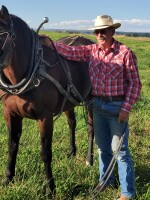A year or so ago I reported that virtual fencing systems were being developed to keep cattle, sheep and goats confined to specific areas of pastures and ranges. What it meant was that paddocks could be set up without using fence wire, barb wire or other fencing materials. Using a computer interface and a digital topographical map, and cell phone signals, ranchers designate grazing area boundaries on ranch pastures or hundreds of acres of un-fenced range lands by setting electronic boundaries that are received by GPS-enabled collars that are placed around the necks of all of the the adult cattle, sheep or goats in a herd. These collars collars use replaceable batteries that power the electrical components for about six months before they need to be replaced.
At first, virtual fencing sounded a bit like something out of a science fiction novel, but the system is pretty straight forward, since it operates by sending a signal to the collar on each individual animal that first warns them with audio tones if they begin to get close to the virtual boundary. If they disregard the warning tones, they will receive an electric shock from the collar that has the intensity similar to a regular electric fence charger, which is usually strong enough to dissuade animals from continuing on through the virtual fence.
Federal agencies that oversee public lands in the West are very supportive of these systems, because construction and maintenance of permanent fences is very expensive because the rough terrain on most of BLM and national forest grazing lands makes fence building both very time consuming and difficult.
I haven’t been keeping up with this technology until a couple of weeks ago, when a friend asked me to help him assemble a virtual fence system base station, which he’ll use on his family’s San Juan National Forest grazing allotment and also on leased private land. The base station looks like a 4’ X 5’ shiny aluminum dog house on four legs. It houses the electronics for the system and has 17 foot tall antenna tower for transmitting signals to the collars on each of the animals. It is self contained, using a solar array to charge batteries that operate the system. As I helped him put the base station together, I began to think about how this new technology may change the way livestock producers will utilize forage resources in the future, since construction and maintenance of permanent fences is very expensive for both private land owners and Federal agencies that oversee public lands.
I recently found out that a few ranchers began to use similar systems last summer on the San Juan National Forest, and a rancher who had cattle on the same allotment as my friend finished gathering in less than half the time it took for him to finish up his gather, which sold him on the system. He also lost two cows that they were unable to find after several days of hard riding. He doesn't know if they are still up in the mountains, died or were stolen.
Also, here in Southwest Colorado, there is crop residue left in many farm fields that could provide fall feed for cattle and sheep that have come off of mountain rangelands, which up to now hasn’t been possible because many fields have no boundary fences. But livestock producers who have virtual fence systems could now more easily move their animals to these fields for a few weeks of fall grazing, which would benefit both farmers and livestock producers.
British fiction writer Arthur C. Clark wrote, “Any sufficiently advanced technology is indistinguishable from magic.”



